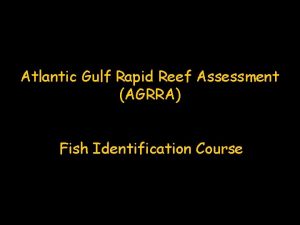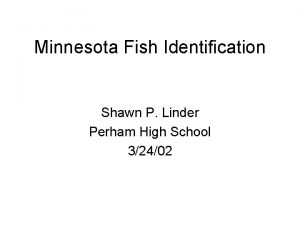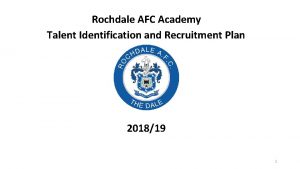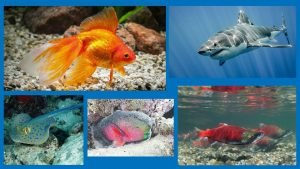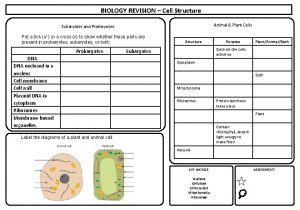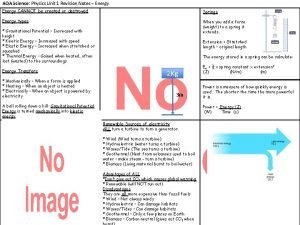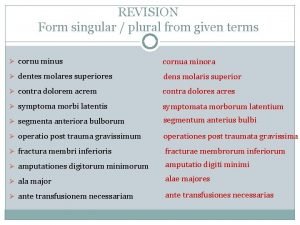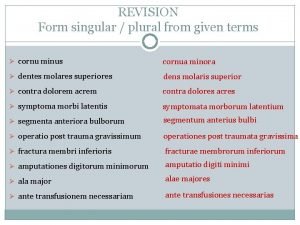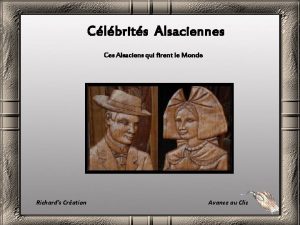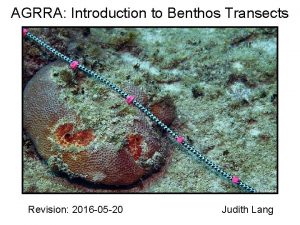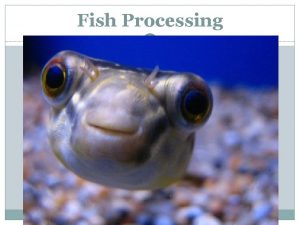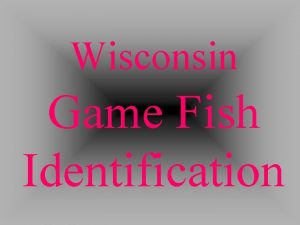AGRRA Fish Identification Course Revision 2016 05 25
























































































































- Slides: 120

AGRRA: Fish Identification Course Revision: 2016 -05 -25 (Scientific Names)

Images in this presentation are Copyright © by Ken Marks and New World Publications. Copyright © Ocean Research & Education Foundation Permission is granted to use this Powerpoint presentation for educational purposes with the AGRRA Program and, with attribution, for other valid educational purposes. All other uses are strictly prohibited.

Pomacanthidae The angelfish family contains only a handful of species that are thin bodied and have rounded or oval profiles. Angelfishes can be distinguished from the closely related butterflyfishes by the presence of a rear-pointing spine extending from the lower part of the gill cover and their generally larger size compared to the butterflyfish. Two tiny species of angelfishes (genus Centropyge) are not included as they are uncommon species usually restricted to deeper reefs.

Yellow tail Dark blue “crown” ringed in brilliant blue Holacanthus ciliaris

Body bars curved Holacanthus ciliaris (juvenile)

Fins bordered in yellow Holacanthus bermudensis

Body bars straight Holacanthus bermudensis (juvenile)

Black with yellow rims on scales Rounded tail Pomacanthus paru

Yellow oval on curved tail Pomacanthus paru (juvenile)

Gray body with dark scales Square-cut tail with light margin Yellow inner face of pectoral Pomacanthus arcuatus

Square-cut tail with light margin Pomacanthus arcuatus (juvenile)

Black body Yellow forebody and tail Holacanthus tricolor

Black spot ringed in brilliant blue Holacanthus tricolor (juvenile)

Chaetodontidae Butterflyfishes, like the closely related angelfishes, are thin bodied fishes that have rounded or oval profiles but they are generally smaller and lack the spine on the gill cover. Butterflyfishes are often seen in pairs as they flit about the reef. Most species have a dark bar running through the eyes to conceal them. This is combined with false eye spots on the tail of most juveniles (and some adults) to further create the illusion that the fish is pointing the other way (to confuse predators).

Two black midbody bands Chaetodon striatus

Black spot ringed in white Chaetodon capistratus

Black spot on edge of rear dorsal All fins (except pectoral) bright yellow Chaetodon ocellatus

Broad dark area on rear body Chaetodon sedentarius

Yellow to black bar runs to eye but not below Long pointed snout Prognathodon aculeatus

Acanthuridae A sharp scalpel-like spine on either side of the tail base gives this family its name. These herbivorous fishes are often seen as singles or in small groups but they also may form large schools which often use their numbers to overcome the defenses of damselfishes to feed upon their algal gardens. There are only three species in the Tropical Western Atlantic and they all have similar coloration but they can be identified by subtle but reliable distinguishing features.

White to yellow spine Acanthurus coeruleus

Bright yellow overall Acanthurus coeruleus (juvenile)

Pectoral fin translucent, often yellowish Acanthurus tractus

May show faint or bold body bars Dark area at base of pectoral fin Acanthurus chirurgus

Silvery (Miscellaneous) Several families of silvery colored fishes are grouped here (jacks, barracudas, porgies and sea chubs). It is no surprise that the prey items of this diverse group of species covers a wide range. Barracudas and Jacks prey on fishes both up in the water column as well as down on the reef. Porgies feed on benthic invertebrates (including the Long-spined Urchin, Diadema antillarum). Chubs are herbivores feeding on benthic algae. There actually four nearly identical species of chubs in the area but as they are functionally equivalent on the reef they are recorded generically as chubs rather than to species.

Black and bright blue border on back and lower tail Caranx ruber

High back profile Dark pectoral Orangish area Trachinotus falcatus

Long, cylindrical body often with scattered black blotches on side Underslung jaw with large teeth Sphyraena barracuda

Small black spot on pectoral base Slight overbite Calamus penna

Bluish saucer-shaped line under eye Bluish blotch on pectoral base Calamus calamus Corners of mouth yellow

Long sloping head Large mouth with thick lips Calamus bajonado

Blue rectangular stripe behind eye Calamus pennatula

Football-shaped body Kyphosus spp. (multiple species)

Haemulidae Grunts and snappers (next) are closely related families but grunts are generally smaller and tend to have more deeply notched tails. While they lack the sharp canine teeth of snappers, they do have pharyngeal teeth deep in their throats that when ground together make a grunting sound (amplified by the air-filled swim bladder). Grunts may aggregate in large schools (sometimes of mixed species) during the day resting in sheltered areas on the reef by day. They spread out over sand flats and seagrass beds to feed on benthic invertebrates at night.

Diagonal yellow stripes below lateral line Haemulon flavolineatum

Blue stripes with black edges Dark tail and rear dorsal Haemulon sciurus

5 or 6 yellow stripes Small cylindrical body Haemulon chrysargyreum

Checkered pattern on body scales All fins whitish Yellow and blue stripes only on head Haemulon plumieri

Thin yellow stripes Darkish rear fins Haemulon carbonarium

Yellowish green back Yellow saddle on tail base Black stripes on upper body Haemulon macrostomum

Thick gold line at midbody and thinner line on back Usually dark spot on tail base Haemulon aurolineatum

Black stripe runs from snout to eye Black diagonal stripe on back runs onto tail forming V Haemulon melanurum

Black spots on scales form diagonal bands Gold ring around eye Haemulon parra

High back profile Black patch behind pectoral Anisotremus surinamensis

High back profile Small eye with white iris Haemulon album

High back profile Yellow fins Yellow nape Two black bands on head Anisotremus virginicus

Lutjanidae The common name of this family comes from their behavior of snapping their jaws when hooked. Snappers are generally larger than the similarly shaped grunts and have prominent canine teeth and a single, continuous dorsal fin that further helps to distinguish them from grunts. Like grunts, they are also nocturnal hunters feeding on benthic invertebrates as well as small fishes. During the day they may form small to large aggregations but are often solitary. The Yellowtail Snapper is much more streamline shaped with a lower body profile and a widely forked tail. This species is often found well above the reef in mid-water.

Usually has midbody spot Blue line below eye Pointed anal fin Lutjanus analis

Largest snapper; often silvery gray with no markings but may have faint bars Thick lips with large teeth Lutjanus cyanopterus

Pale triangular patch under eye Lutjanus jocu

Reddish margin on tail Lutjanus mahogoni

Usually dark blotch on back Narrow parallel yellow stripes on body Lutjanus synagris

Gray often with no markings Occasionally dark band from lip through eye Lutjanus griseus

Yellow midbody stripe merges into yellow tail Ocyurus chrysurus

Silvery to yellow body with all yellow fins May have faint bars on back (especially young) Lutjanus apodus

Pomacentridae Damselfishes are a common inhabitant on most reef habitats and many species can be difficult to identify to species (especially as juveniles). Many damselfish species are planktivores—picking small specks out of the water columns. The only species of interest to AGRRA are the two species that create and tend algal gardens (often killing areas of coral in the process).

Yellow crescent over eye Spots on tail base and pectoral fin base Stegastes planifrons

Dark body with a few bright blue spots Yellow tail Microspathodon chrysurus

Blue body with brilliant blue spots Clear tail Microspathodon chrysurus (juvenile)

Serranidae (Epinephelinae) Groupers are the best known members of the sea bass family and the only part of that family of interest to AGRRA. The large groupers in the genera Epinephelus and Mycteroperca are often some of the first species to disappear from over-fished reefs. Often, only the smaller grouper species in the genus Epinephelus and those in the genus Cephalopholis may be left in any abundance on reefs receiving fishing pressure. On reefs with severely degraded fish populations these too may be absent. Most groupers tend to remain relatively hidden during the day lurking in the shadows of ledges or wrecks and blending in with their surroundings with colors and markings that provide camouflage. All large groupers should be counted but

Diagonal bands on head Black saddle spot on tail base Dark bars on body Epinephelus striatus

Rectangular markings on back Pale edge on pectoral Mycteroperca bonaci

Oval markings on back Dark margin on tail Yellow to pale outer edge of pectoral Mycteroperca venenosa

Pectoral margins pale Yellow around corners of mouth Mycteroperca interstitialis

Diagonal “tiger-stripe” bars on back Mycteroperca tigris

3 to 5 dark spots along base of dorsal fin Tail more rounded than similar species Cephalopholis cruentata

Tail and rear fins have dark margin with thin white edge Epinephelus guttatus

Dark blotches along back Black saddle on tail base Epinephelus adscensionis

Two black spots on tail base Two black spots on lower lip Reddish-brown color phase Cephalopholis fulva

Bicolor phase Cephalopholis fulva

Golden variation (rare) Cephalopholis fulva

Scaridae Parrotfishes have teeth fused into parrot-like beaks and strong jaws. These adaptations serve them well as they feed by scraping algae from areas of dead coral. Occasionally, they will also bite live coral—in some cases leaving bright white scars to mark the boundaries of their territory. Like the closely related wrasses, parrotfishes have several life stages marked with, often drastically different, colors and markings which can make identification difficult. These phases include the Juvenile Phase (JP), Initial Phase (IP), and Terminal Phase (TP). JP contains both males and females, IP contains sexually mature females (and sometimes immature and mature males), and TP are always sexually mature males.

All blue body Scarus coeruleus

Dark “midnight” blue body Lighter blue markings on face Scarus coelestinus

Orange head, forebody and tail Green rear body Scarus guacamaia

Blue-green markings (“Moustache”) around mouth Pale bar along pectoral Scarus vetula (TP)

Gray to black body and tail White stripe from pectoral to tail Scarus vetula (IP)

Yellow spot at corner of gill cover Yellow area at tail base and crescent on tail Sparisoma viride (TP)

Scattered large white scales with dark outlines Red belly and tail Sparisoma viride (IP)

3 rows of small white spots on body White bar on tail Sparisoma viride (JP)

Two green lines pass by eye Pink borders on tail Yellow wash on side Scarus taeniopterus (TP)

Dark borders on tail No gold wash on nose Scarus taeniopterus (JP/IP)

Short pink bars between scales Blue borders on tail Yellow spot or stripe above pectoral base Scarus iseri (TP)

No dark borders on tail Gold wash on nose Scarus iseri (IP)

Yellow blotch and small black spots on upper forebody Red anal fin Red band under eye Sparisoma aurofrenatum (TP)

White saddle spot Sparisoma aurofrenatum (IP)

White to pink saddle spot 2 white body stripes Sparisoma aurofrenatum (JP)

Blue streak behind pectoral Red tail crescent Black blotch at pectoral base Sparisoma chrysopterum (TP)

White blotch on tail base Black blotch at pectoral base Pale to pinkish body color can be difficult to distinguish from Yellowtail Parrotfish Sparisoma chrysopterum (IP)

Yellow crescent on tail Black blotch at pectoral base Sparisoma rubripinne (TP)

Yellow tail Pale body; ventral fin often pinkish Sparisoma rubripinne (IP)

TP: Faint green blotch above pectoral Yellow-gold to red iris IP: Red overall Sparisoma atomarium (TP & IP)

Labridae Wrasses are closely related to the parrotfishes and share similar difficulties in species identification due to having multiple growth phases (JP, IP & TP). Unlike the parrotfishes, wrasses eat benthic invertebrates and do not scrape algae so their mouths have noticeable small pointy teeth instead of parrot-like “beaks” of fused teeth. Most wrasses are elongate and slender bodied but a group of wrasses known as hogfishes have higher back profiles and elongated snout-like mouths that they use to root around in rocks and rubble to find their invertebrate prey (including the Long-spined Urchin, Diadema antillarum).

First 3 dorsal spines unusually long IP: Black blotch on base of rear dorsal Lachnolaimus maximus

Purple upper forebody Yellow belly and tail Bodianus rufus

IP: White spots along back Green margin on tail Halichoeres radiatus (IP)

Dark blue spot on mid-dorsal and tail base Halichoeres radiatus (JP)

Wavy lines behind eyes Dark mid-body bar Yellow head Halichoeres garnoti (TP)

Thin blue lines on tail Wavy lines behind eyes Halichoeres garnoti (IP)

Brilliant blue mid-body stripe Halichoeres garnoti (JP)

Green and yellow bicolor spot above pectoral Triangular markings on tail corners Halichoeres bivittatus (TP)

White with dark mid -body stripe Halichoeres bivittatus (JP)

Tetraodontidae/Diodontidae/Ostraciidae A few members of the pufferfish, porcupinefish, and boxfish families are included in the AGRRA fish protocol since they are known to prey upon small Long-spined Urchin, Diadema antillarum. Pufferfishes and porcupinefishes (closely related families) are capable of inflating their bodies by drawing in water as a means of defense. Boxfishes, instead, protect themselves with a triangular, bony box of armor which also makes their bodies inflexible so they are relatively slow and clumsy swimmers.

Two dark bands on tail Row of spots along mid-body Sphoeroides spengleri

Black spots on all fins Diodon hystrix

No spots on fins Long spines on head Diodon holocanthus

Black spots on white body Spines in front of anal fin Lactophrys bicaudalis

Balistide & Monacanthidae Triggerfishes and filefishes are closely related families with subtle differences. They are part of the superfamily known as leatherjackets due to the rough texture of their skin. Both families have an elongate first dorsal spine that may be raised or lowered. Triggerfishes have a second smaller ridged spine “the trigger” behind the first which may be used to lock this larger spine into place. The dorsal spine of filefishes tent to be longer and thicker than those of triggerfishes.

Black lines radiate out from eye 2 blue lines on face Balistes vetula

Uniformly gray; black blotch at base of pectoral Canthidermes sufflamen

Blackish body; pale blue lines along dorsal and anal fin bases Melichthys niger

Small orange spots on body White saddle spot on tail base Canthidermis pullus

Usually has pale white spots Extended belly appendage Orange spines on tail base Canthidermis macrocerus

May be unspotted orange with pale mid -body area Orange spines on tail base Canthidermis macrocerus

Muraenidae Morays include some of the largest eels encountered on the reef. They have no pectoral or ventral fins and their dorsal, tail, and anal fins are merged into a single continuous fin that extends from behind the head around the tail and midway up the lower part of the body. Since morays lack external gill covers they constantly open and close their mouths to force water over their gills. This is often interpreted as aggression when it is only respiration. Though they are not aggressive, they can inflict a serious bite so they are best left unmolested.

Uniformly green with no markings Gymnothorax funebris

Dark border along dorsal Covered with dark speckling Gymnothorax moringa

Golden ring around pupil Brown with fine yellow spots; golden tail tip not often seen Gymnothorax miliaris

Scorpaenidae A member of the scorpionfish family, lionfish are not native to the Tropical Western Atlantic. This very distinctive exotic species from the Indo-Pacific has become naturalized in our waters due to escaped individuals kept in aquariums which were able to find mates and begin breeding in the wild. In just a few years lionfish have spread throughout the region and lacking predators have attained problematic densities on many reefs resulting in a loss of biodiversity and biomass to these hungry predators. The venomous spines of the dorsal and the ventral and anal fins can inflict a painful wound so care should be taken around lionfish.

Featherlike dorsal and pectorals Reddish brown body bands Pterois volitans
 One fish two fish red fish blue fish ride
One fish two fish red fish blue fish ride Agrra
Agrra Agrra
Agrra Characteristics of fish
Characteristics of fish Twofish and blowfish
Twofish and blowfish Active revision vs passive revision
Active revision vs passive revision Positive identification
Positive identification Dogfish mn
Dogfish mn Shellfish identification
Shellfish identification Texas freshwater fish identification
Texas freshwater fish identification Microsoft official academic course microsoft excel 2016
Microsoft official academic course microsoft excel 2016 Microsoft official academic course microsoft word 2016
Microsoft official academic course microsoft word 2016 Microsoft official academic course microsoft word 2016
Microsoft official academic course microsoft word 2016 Rochdale afc youth
Rochdale afc youth Fishbony
Fishbony Bony vs cartilaginous fish
Bony vs cartilaginous fish A big fish swims up and swallows a small fish at rest
A big fish swims up and swallows a small fish at rest Sticks market form of fish
Sticks market form of fish Course title and course number
Course title and course number Chaine parallèle muscle
Chaine parallèle muscle T junction brick wall
T junction brick wall Decimals revision
Decimals revision Context of journey's end
Context of journey's end Pem convention
Pem convention Ocr computer science checklist
Ocr computer science checklist Past continuous engleski
Past continuous engleski Modal verbs revision
Modal verbs revision Coding and logic exam
Coding and logic exam Year 6 science revision
Year 6 science revision 16⅓(64/4)
16⅓(64/4) Konsep abcde
Konsep abcde Present simple revision
Present simple revision Revision clipart
Revision clipart Animal biology revision
Animal biology revision Forces revision poster
Forces revision poster Nancy sommers revision strategies
Nancy sommers revision strategies Mix design as per is 10262 : 2019
Mix design as per is 10262 : 2019 Elt oup student headway
Elt oup student headway Year 7 science revision
Year 7 science revision Social class sailmaker
Social class sailmaker Complex numbers revision
Complex numbers revision Adverbs of frequency exercises resueltos
Adverbs of frequency exercises resueltos How are bays formed
How are bays formed External forms of social control
External forms of social control Revision techniques gcse powerpoint
Revision techniques gcse powerpoint E. writing connection
E. writing connection I have begun to plant thee
I have begun to plant thee Revision.english.outwood
Revision.english.outwood Ict chapter 1
Ict chapter 1 Punctuation revision
Punctuation revision Catering revision
Catering revision At wendy's washateria all of the dryer
At wendy's washateria all of the dryer Euclidean geometry
Euclidean geometry Anuradha perera model
Anuradha perera model Ogat english revision
Ogat english revision Translation
Translation Present continuous u engleskom jeziku
Present continuous u engleskom jeziku General revision of assessments and property classification
General revision of assessments and property classification Literals in python
Literals in python Write an invitation letter
Write an invitation letter Maths revision.com
Maths revision.com Romeo and juliet revision notes
Romeo and juliet revision notes Find the missing angle
Find the missing angle Setting of great gatsby
Setting of great gatsby Revision vs editing
Revision vs editing An inspector calls summary act 1
An inspector calls summary act 1 Iso 14001 revision
Iso 14001 revision Maths revision.com
Maths revision.com Que se pone en el marco contextual
Que se pone en el marco contextual Fire needs 3 things
Fire needs 3 things Look at the signs and rewrite them in the active
Look at the signs and rewrite them in the active Meta ethics
Meta ethics Material properties definitions
Material properties definitions Creative i media revision
Creative i media revision Factors affecting software quality
Factors affecting software quality Ib psychology revision
Ib psychology revision Unit 4 criminology wjec
Unit 4 criminology wjec Jekyll and hyde revision
Jekyll and hyde revision Gtpal
Gtpal Navsea 05 tech warrant holders
Navsea 05 tech warrant holders Othello revision
Othello revision Ict igcse practical revision presentation
Ict igcse practical revision presentation Revision learning objectives
Revision learning objectives Ict igcse theory
Ict igcse theory Fast revision techniques
Fast revision techniques Akt exam revision
Akt exam revision Marco
Marco Ebbinghaus formula
Ebbinghaus formula French year 7 revision booklet
French year 7 revision booklet The sailmaker play
The sailmaker play Animal farm revision guide
Animal farm revision guide Work area protection manual
Work area protection manual Tenses englisch
Tenses englisch Context bayonet charge
Context bayonet charge Work area protection manual 2019
Work area protection manual 2019 Speed time distance equation
Speed time distance equation Thou/thee in modern english
Thou/thee in modern english Aqa gcse geography revision checklist
Aqa gcse geography revision checklist Unit 4 criminology revision
Unit 4 criminology revision As revision 101
As revision 101 Mathsrevision.com
Mathsrevision.com Utilerías de revisión
Utilerías de revisión Gravida para
Gravida para Catering gcse revision
Catering gcse revision Ict igcse theory revision presentation
Ict igcse theory revision presentation What is revision
What is revision The chemical that promotes phototropism is _____.
The chemical that promotes phototropism is _____. Revision present simple and continuous
Revision present simple and continuous Steps portfolio management process
Steps portfolio management process Recurso de reconsideración anses modelo
Recurso de reconsideración anses modelo Scratch revision
Scratch revision Métallurgie fischer serrure molsheim
Métallurgie fischer serrure molsheim Revision part 1
Revision part 1 The handmaids tale thesis
The handmaids tale thesis Nemotecnia amplia atls
Nemotecnia amplia atls O happy dagger quote analysis
O happy dagger quote analysis What s your hobby
What s your hobby The crucible revision
The crucible revision Product design gcse revision
Product design gcse revision Recurso de revision
Recurso de revision Eduqas a level music
Eduqas a level music

